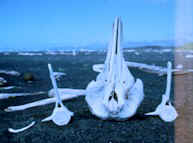
How do scientists determine the age of a marine mammal?
Scientists use different methods to determine marine mammal life spans.
1) The teeth, bones and other hard parts (like nails or teeth) can be used to estimate age in marine mammals. Teeth in cetaceans are often aged by counting lines in the dentine of the tooth. The teeth of pinnipeds are also aged by counting the dentine or cementum of the tooth. Lines in the teeth of pinnipeds and toothed whales can be read like tree rings to determine the age of an animal. Usually, one line in the tooth corresponds to one year of life for the animal.
2) For marine mammals without teeth, other hard parts (such as ear bones) may be used to estimate age.
3) Approximate age is sometimes estimated by the size of an animal.

The bones of this stranded North Pacific bottlenose whale will be used to determine the whale's size and age at death.
What are the advantages to knowing the age of an animal?
Knowing the age of marine mammals allows the determination of age-specific statistics (survival, reproduction, etc.) for populations. Such statistics are important to determine the age structure for a population of marine mammals (for example, the proportion of immature and mature animals in the population), as well as whether the population is increasing, stable, or declining.
This portion of the NMML website is intended for a student audience and their educators.
Information within the education website should not be cited in scientific journals or publications.

